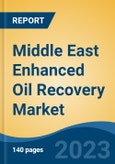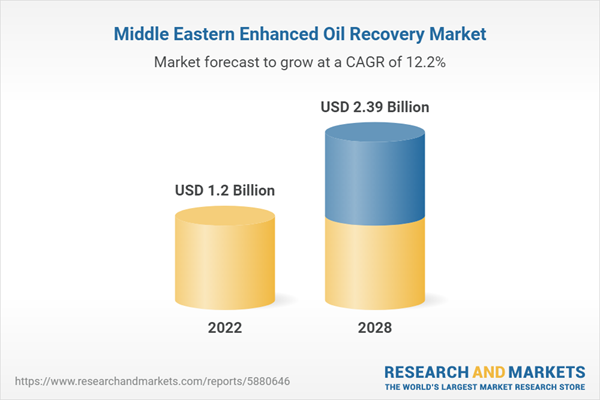Speak directly to the analyst to clarify any post sales queries you may have.
10% Free customizationThis report comes with 10% free customization, enabling you to add data that meets your specific business needs.
EOR techniques are classified into three types: gas injection, heat injection, and chemical injection. Gas injection, which employs gases such as natural gas, nitrogen, or carbon dioxide (CO2), accounts for roughly 60% of EOR output. The most widely employed technique in improved oil recovery is gas injection or miscible flooding. Miscible flooding refers to injection procedures that use miscible gases in the reservoir. Various technologies are employed in this approach to heat the crude oil in the formation to reduce its viscosity and/or evaporate portion of the oil, lowering the mobility ratio. Cyclic steam injection, steam flooding, and combustion are all methods. These strategies increase the sweep and displacement efficiency.
Increasing Demand for Energy Security to Boost the Middle East Enhanced Oil Recovery Market
The Middle East has long been the center of the world oil market, with 810 billion barrels of known reserves (50 percent of global total) and 28 million barrels per day of output (30 percent of global total). The Middle East today consumes roughly 33% of the oil it produces, up from 20% in 2000. The total population is around 260 million, with a 2.2% annual growth rate. A barrel of oil may be extracted for as little as USD5 in Saudi Arabia. Furthermore, massive oil subsidies stimulate demand while promoting wasteful behavior. Due to which the market of middle east enhanced oil recovery is rising rapidly.Qatar Energy has awarded Samsung C&T an EPC contract for its industrial cities’ solar power project (IC Solar), which comprises the construction of two large-scale PV solar power plants in Qatar's industrial towns. The project is Qatar Energy Renewable Solutions' first investment, and it will invest in and hold Qatar's renewables and other sustainable efforts in the future.
Companies are working hard to improve output from existing fields that have reached their maximum production capacity to meet increased demand for oil and gas. According to the findings of a company’s study, mature fields account for around 70% of oil and gas output. As a result, these businesses are now concentrating their efforts on boosting recovery and prolonging the life of older fields utilizing EOR technology. As a result, they are outpacing output, raising market demand for more oil recovery.
Gradual shift towards optimizing oil recovery from reservoirs and upcoming projects of oil and gas
In 2021, the Middle East consumed 374.9 million metric tons of oil, a 3.7 percent increase over the previous year. Figures increased by 211 million metric tons throughout the study period, culminating at 401.7 million metric tons in 2018. There was a rise in global oil usage as of 2021. In comparison, oil consumption in Europe increased by 5.2 percent. Hence, the Middle East Enhanced oil recovery market is expected to grow with a high CAGR in the forecast period. Since, oil consumption is rising in middle east countries hence the demand for EOR is also growing rapidly.Large amounts of generated water are frequently pumped to the surface by enhanced oil recovery wells. This water includes brine, as well as harmful heavy metals and radioactive compounds. If not adequately regulated, this may be extremely harmful to drinking water supplies and the ecosystem in general. By injecting generated water far down, disposal wells prevent surface pollution of soil and water, and these factors are restraining the market growth.
Market Segmentation
The Middle East Enhanced Oil Recovery Market is divided into technology, application, country and competitive landscape. Based on Technology, the market is segmented into gas, thermal, chemical, microbial, others. Based on Application, the market is segmented into Offshore, Onshore. Based on country the market is divided into Saudi Arabia, UAE, Qatar, Kuwait, Bahrain and rest of Middle East.Market Players
Major market players in the Middle East Enhanced Oil Recovery Market are Schlumberger Limited, BP P.L.C., Saudi Aramco, Petroleum Development Oman, China National Offshore Oil Corporation, Linde AG and Abu Dhabi National Oil Company, SGS SA, Kemira Oyj, Linde Plc.Report Scope:
In this report, the Middle East Enhanced Oil Recovery Market has been segmented into following categories, in addition to the industry trends which have also been detailed below:Middle East Enhanced Oil Recovery Market, By Technology:
- Gas
- Thermal
- Chemical
- Microbial
- Others
Middle East Enhanced Oil Recovery Market, By Application:
- Offshore
- Onshore
Middle East Enhanced Oil Recovery Market, By Country:
- Saudi Arabia
- UAE
- Qatar
- Kuwait
- Bahrain
- Rest of Middle East
Competitive Landscape
Company Profiles: Detailed analysis of the major companies present in the Middle East Enhanced Oil Recovery Market.Available Customizations:
The publisher offers customizations according to a company's specific needs.This product will be delivered within 1-3 business days.
Table of Contents
Companies Mentioned
- Schlumberger Limited,
- BP P.L.C
- Saudi Aramco
- Petroleum Development Oman
- China National Offshore Oil Corporation
- Linde AG
- Abu Dhabi National Oil Company
- SGS SA
- Kemira Oyj
- Linde Plc
Table Information
| Report Attribute | Details |
|---|---|
| No. of Pages | 140 |
| Published | September 2023 |
| Forecast Period | 2022 - 2028 |
| Estimated Market Value ( USD | $ 1.2 Billion |
| Forecasted Market Value ( USD | $ 2.39 Billion |
| Compound Annual Growth Rate | 12.1% |
| Regions Covered | Middle East |
| No. of Companies Mentioned | 10 |









